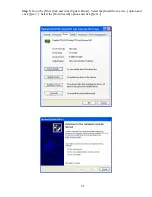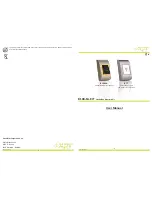
35
Terminology
10BASE-T:
IEEE 802.3 specifications for 10 Mbps Ethernet over two pairs of Category 3, 4, or 5 UTP cable.
100BASE-TX:
IEEE 802.3u specification for 100 Mbps Fast Ethernet over two pairs of Category 5 UTP cable.
1000BASE-T:
IEEE 802.3ab specification for Gigabit Ethernet over four pairs of Category 5 UTP cable.
Adapter:
A device used to connect end-user nodes to the network; each contains an interface to a specific type
of computer or system bus, e.g. EISA, ISA, PCI, PCMCIA, CardBus, etc.
Auto-Negotiation
: A signaling method that allows each node to define its operational mode (e.g., 1000 Mbps
and half/full duplex) and to detect the operational mode of the adjacent node.
Backbone
: The core infrastructure of a network. It is the portion of the network that transports information
from one central location to another central location where it is unloaded onto a local system.
Bandwidth:
The difference between the highest and lowest frequencies available for network signals. Also
synonymous with wire speed, the actual speed of the data transmission along the cable.
Collision:
A condition in which packets transmitted over the cable interfere with each other. The interference
makes both signals unintelligible.
Collision Domain:
Single CSMA/CD LAN segment.
CSMA/CD:
CSMA/CD (Carrier Sense Multiple Access/Collision Detect) is the communication method
employed by Ethernet and Fast Ethernet.
DHCP:
Dynamic Host Configuration Protocol. This protocol automatically configures the TCP/IP settings of
every computer on your home network.
DNS:
DNS stands for Domain Name System, which allows Internet host computers to have a domain name
(such as www.smc.com) and one or more IP addresses (such as 192.34.45.8). A DNS server keeps a database of
host computers and their respective domain names and IP addresses, so that when a domain name is requested
(as in typing "www.smc.com" into your Internet browser), the user is sent to the proper IP address. The DNS
server address used by the computers on your home network is the location of the DNS server your ISP has
assigned.
DSL:
DSL stands for Digital Subscriber Line. A DSL modem uses your existing phone lines to transmit data at
high speeds.
End Station:
A workstation, server, switch, bridge or router.
Ethernet:
A network communication system developed and standardized by DEC, Intel, and Xerox, using
baseband transmission, CSMA/CD access, logical bus topology and coaxial cable. The successor IEEE 802.3
standard provides for integration into the OSI model and extends the physical layer and media with repeaters
and implementations that operate on fiber, thin coax and twisted-pair cable.




































